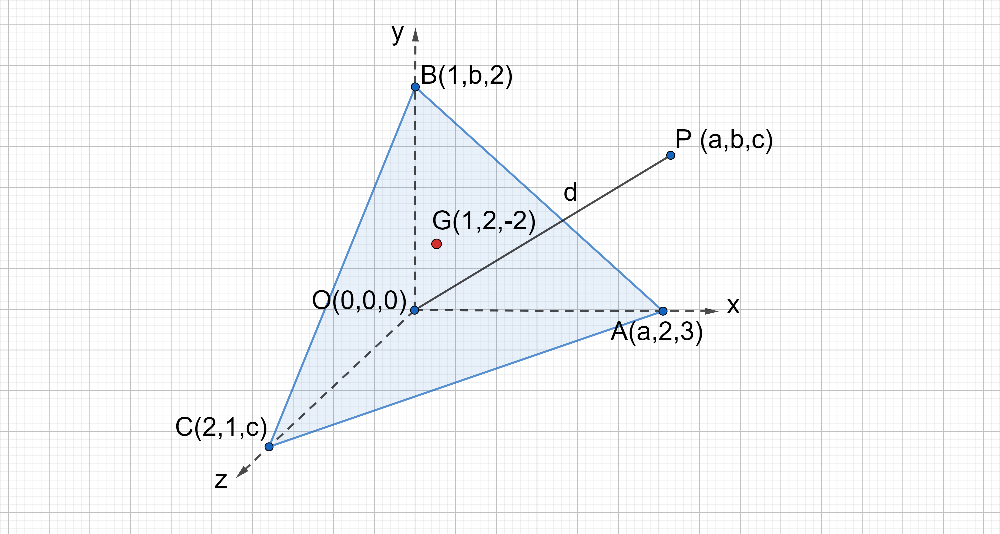
If the centroid of tetrahedron OABC where A, B, C are given by (a, 2, 3), (1, b, 2) and (2, 1, c) respectively is (1, 2, -2), then distance of P (a, b, c) from origin is
a) $\sqrt{195}$
b) $\sqrt{14}$
c) $\sqrt{\dfrac{107}{14}}$
d) $\sqrt{13}$
Answer
487.8k+ views
Hint: The centroid or geometric center of a figure is the arithmetic mean position of all the points in the figure. Let ABCD is a tetrahedron whose vertices \[\text{A(}{{\text{x}}_{1}}\text{,}{{\text{y}}_{1}}\text{,}{{\text{z}}_{1}}\text{); B(}{{\text{x}}_{2}}\text{,}{{\text{y}}_{2}}\text{,}{{\text{z}}_{2}}\text{); C(}{{\text{x}}_{3}}\text{,}{{\text{y}}_{3}}\text{,}{{\text{z}}_{3}}\text{)}\] and $\text{D(}{{\text{x}}_{4}}\text{,}{{\text{y}}_{4}}\text{,}{{\text{z}}_{4}}\text{)}$then, the centroid (G) is given as:
$G(x,y,z)=\left[ \dfrac{{{x}_{1}}+{{x}_{2}}+{{x}_{3}}+{{x}_{4}}}{4},\dfrac{{{y}_{1}}+{{y}_{2}}+{{y}_{3}}+{{y}_{4}}}{4},\dfrac{{{z}_{1}}+{{z}_{2}}+{{z}_{3}}+{{z}_{4}}}{4} \right]$. Use this formula to find the centroid for triangle OABC and then equate the coordinates with the point (1, 2, -2) to get the values of a, b and c. Now, we get point P (a, b, c). Then, find the distance between point origin and point P (a, b, c) using distance formula:
\[d=\sqrt{{{\left( {{x}_{2}}-{{x}_{1}} \right)}^{2}}+{{\left( {{y}_{2}}-{{y}_{1}} \right)}^{2}}+{{\left( {{z}_{2}}-{{z}_{1}} \right)}^{2}}}\]
Complete step by step answer:
Consider the diagram of tetrahedron OABC given below, whose vertices are $\text{A(a,2,3);B(1,b,2);C(2,1,c)}$ and $\text{O(0,0,0)}$.
G (1, 2, -2) represents the centroid of the tetrahedron, and P (a, b, c) is the arbitrary point at a distance ‘d’ from the origin.

For a tetrahedron with vertices, \[\text{A(}{{\text{x}}_{1}}\text{,}{{\text{y}}_{1}}\text{,}{{\text{z}}_{1}}\text{); B(}{{\text{x}}_{2}}\text{,}{{\text{y}}_{2}}\text{,}{{\text{z}}_{2}}\text{); C(}{{\text{x}}_{3}}\text{,}{{\text{y}}_{3}}\text{,}{{\text{z}}_{3}}\text{)}\] and $\text{D(}{{\text{x}}_{4}}\text{,}{{\text{y}}_{4}}\text{,}{{\text{z}}_{4}}\text{)}$, the centroid (G) is given as:
$G(x,y,z)=\left[ \dfrac{{{x}_{1}}+{{x}_{2}}+{{x}_{3}}+{{x}_{4}}}{4},\dfrac{{{y}_{1}}+{{y}_{2}}+{{y}_{3}}+{{y}_{4}}}{4},\dfrac{{{z}_{1}}+{{z}_{2}}+{{z}_{3}}+{{z}_{4}}}{4} \right]$
Therefore, for the given tetrahedron OABC whose vertices are $\text{A(a,2,3);B(1,b,2);C(2,1,c)}$ and $\text{O(0,0,0)}$, the centroid is
\[\text{G}(1,2,-2)=\left[ \dfrac{\text{a}+1+2+0}{4},\dfrac{2+\text{b}+1+0}{4},\dfrac{3+2+\text{c}+0}{4} \right]......(1)\]
By equating the coordinates of centroid in equation (1), we get:
\[\begin{align}
& \dfrac{3+a}{4}=1......(2) \\
& \dfrac{b+3}{4}=2......(3) \\
& \dfrac{5+c}{4}=-2.......(4) \\
\end{align}\]
So, we get values of a, b and c from equation (2), (3) and (4);
\[\begin{align}
& \Rightarrow a=1 \\
& \Rightarrow b=5 \\
& \Rightarrow c=-13 \\
\end{align}\]
Since the arbitrary point P is given as P (a, b, c). Substituting values of a, b, and c, we can write it as:
P (1, 5, -13)
Now, we need to find the distance between P (1, 5, -13) and origin O (0, 0, 0).
To find distance between two points \[\text{P(}{{\text{x}}_{1}}\text{,}{{\text{y}}_{1}}\text{,}{{\text{z}}_{1}}\text{) and Q(}{{\text{x}}_{2}}\text{,}{{\text{y}}_{2}}\text{,}{{\text{z}}_{2}}\text{)}\], use distance formula, i.e.
\[d=\sqrt{{{\left( {{x}_{2}}-{{x}_{1}} \right)}^{2}}+{{\left( {{y}_{2}}-{{y}_{1}} \right)}^{2}}+{{\left( {{z}_{2}}-{{z}_{1}} \right)}^{2}}}\]
Therefore, distance between P (1, 5, -13) and origin O (0, 0, 0) is:
\[\begin{align}
& d=\sqrt{{{\left( 1-0 \right)}^{2}}+{{\left( 5-0 \right)}^{2}}+{{\left( -13-0 \right)}^{2}}} \\
& =\sqrt{1+25+169} \\
& =\sqrt{195}
\end{align}\]
So, the correct answer is “Option A”.
Note: Another way to find centroid is stated below:
Firstly, find the centroids of each of the triangular faces of the tetrahedron. All the centroids when joined together form a triangle itself. Find the centroid of that triangle, which is the centroid of the tetrahedron. Equate the coordinates and get the values of a, b and c. Hence, find the distance between origin and P (a, b, c).
$G(x,y,z)=\left[ \dfrac{{{x}_{1}}+{{x}_{2}}+{{x}_{3}}+{{x}_{4}}}{4},\dfrac{{{y}_{1}}+{{y}_{2}}+{{y}_{3}}+{{y}_{4}}}{4},\dfrac{{{z}_{1}}+{{z}_{2}}+{{z}_{3}}+{{z}_{4}}}{4} \right]$. Use this formula to find the centroid for triangle OABC and then equate the coordinates with the point (1, 2, -2) to get the values of a, b and c. Now, we get point P (a, b, c). Then, find the distance between point origin and point P (a, b, c) using distance formula:
\[d=\sqrt{{{\left( {{x}_{2}}-{{x}_{1}} \right)}^{2}}+{{\left( {{y}_{2}}-{{y}_{1}} \right)}^{2}}+{{\left( {{z}_{2}}-{{z}_{1}} \right)}^{2}}}\]
Complete step by step answer:
Consider the diagram of tetrahedron OABC given below, whose vertices are $\text{A(a,2,3);B(1,b,2);C(2,1,c)}$ and $\text{O(0,0,0)}$.
G (1, 2, -2) represents the centroid of the tetrahedron, and P (a, b, c) is the arbitrary point at a distance ‘d’ from the origin.

For a tetrahedron with vertices, \[\text{A(}{{\text{x}}_{1}}\text{,}{{\text{y}}_{1}}\text{,}{{\text{z}}_{1}}\text{); B(}{{\text{x}}_{2}}\text{,}{{\text{y}}_{2}}\text{,}{{\text{z}}_{2}}\text{); C(}{{\text{x}}_{3}}\text{,}{{\text{y}}_{3}}\text{,}{{\text{z}}_{3}}\text{)}\] and $\text{D(}{{\text{x}}_{4}}\text{,}{{\text{y}}_{4}}\text{,}{{\text{z}}_{4}}\text{)}$, the centroid (G) is given as:
$G(x,y,z)=\left[ \dfrac{{{x}_{1}}+{{x}_{2}}+{{x}_{3}}+{{x}_{4}}}{4},\dfrac{{{y}_{1}}+{{y}_{2}}+{{y}_{3}}+{{y}_{4}}}{4},\dfrac{{{z}_{1}}+{{z}_{2}}+{{z}_{3}}+{{z}_{4}}}{4} \right]$
Therefore, for the given tetrahedron OABC whose vertices are $\text{A(a,2,3);B(1,b,2);C(2,1,c)}$ and $\text{O(0,0,0)}$, the centroid is
\[\text{G}(1,2,-2)=\left[ \dfrac{\text{a}+1+2+0}{4},\dfrac{2+\text{b}+1+0}{4},\dfrac{3+2+\text{c}+0}{4} \right]......(1)\]
By equating the coordinates of centroid in equation (1), we get:
\[\begin{align}
& \dfrac{3+a}{4}=1......(2) \\
& \dfrac{b+3}{4}=2......(3) \\
& \dfrac{5+c}{4}=-2.......(4) \\
\end{align}\]
So, we get values of a, b and c from equation (2), (3) and (4);
\[\begin{align}
& \Rightarrow a=1 \\
& \Rightarrow b=5 \\
& \Rightarrow c=-13 \\
\end{align}\]
Since the arbitrary point P is given as P (a, b, c). Substituting values of a, b, and c, we can write it as:
P (1, 5, -13)
Now, we need to find the distance between P (1, 5, -13) and origin O (0, 0, 0).
To find distance between two points \[\text{P(}{{\text{x}}_{1}}\text{,}{{\text{y}}_{1}}\text{,}{{\text{z}}_{1}}\text{) and Q(}{{\text{x}}_{2}}\text{,}{{\text{y}}_{2}}\text{,}{{\text{z}}_{2}}\text{)}\], use distance formula, i.e.
\[d=\sqrt{{{\left( {{x}_{2}}-{{x}_{1}} \right)}^{2}}+{{\left( {{y}_{2}}-{{y}_{1}} \right)}^{2}}+{{\left( {{z}_{2}}-{{z}_{1}} \right)}^{2}}}\]
Therefore, distance between P (1, 5, -13) and origin O (0, 0, 0) is:
\[\begin{align}
& d=\sqrt{{{\left( 1-0 \right)}^{2}}+{{\left( 5-0 \right)}^{2}}+{{\left( -13-0 \right)}^{2}}} \\
& =\sqrt{1+25+169} \\
& =\sqrt{195}
\end{align}\]
So, the correct answer is “Option A”.
Note: Another way to find centroid is stated below:
Firstly, find the centroids of each of the triangular faces of the tetrahedron. All the centroids when joined together form a triangle itself. Find the centroid of that triangle, which is the centroid of the tetrahedron. Equate the coordinates and get the values of a, b and c. Hence, find the distance between origin and P (a, b, c).
Recently Updated Pages
Master Class 12 Economics: Engaging Questions & Answers for Success

Master Class 12 Maths: Engaging Questions & Answers for Success

Master Class 12 Biology: Engaging Questions & Answers for Success

Master Class 12 Physics: Engaging Questions & Answers for Success

Master Class 12 Business Studies: Engaging Questions & Answers for Success

Master Class 12 English: Engaging Questions & Answers for Success

Trending doubts
Distinguish between esterification and saponification class 12 chemistry CBSE

Give five points to show the significance of varia class 12 biology CBSE

How was the Civil Disobedience Movement different from class 12 social science CBSE

India is the secondlargest producer of AJute Bcotton class 12 biology CBSE

The Coordination number of bcc fcc ccp hcp is class 12 chemistry CBSE

Difference between saponification and esterificati class 12 chemistry CBSE




